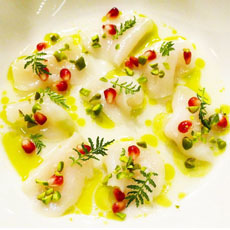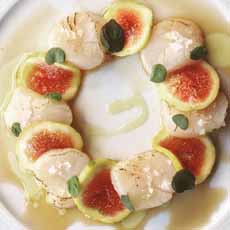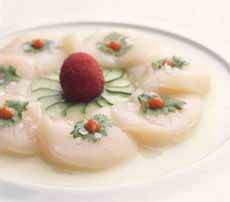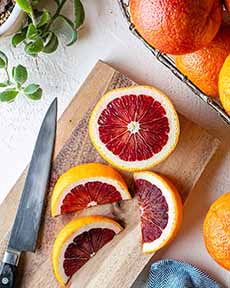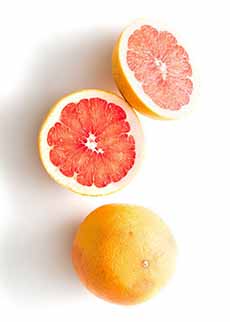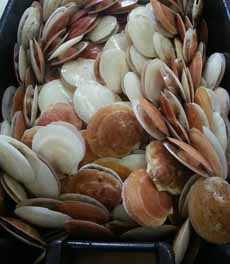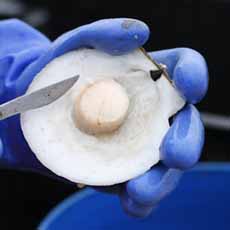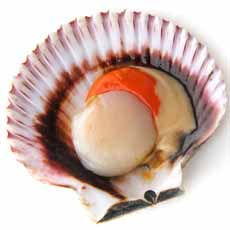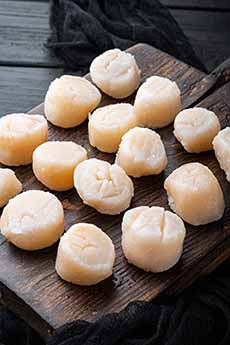TIP OF THE DAY: Raw Scallops Recipes, The Easiest Seafood Appetizers
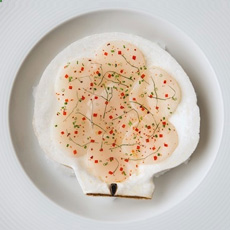 [1] A “flower” presentation from C Chicago (now Ocean Cut Chicago
|
We love sashimi, we love scallops, we love scallop ceviche, and we love how easy it is to make a beautiful raw scallop appetizer (or lightly seared, if you insist).
If your family or guests don’t like the idea of “sashimi,” use the Italian word, for raw fish: crudo. Our very favorite is to slice sea scallops in half and plate them a bit of EVOO, a splash of yuzu, a garnish of salmon caviar or tobiko, and if we have them, a sprinkle of microgreens or minced chives. For a dinner party, with all the other demands of the kitchen, we like to start the meal with a flavorful appetizer that takes very little time to prepare. It’s a great dish for warm or cold weather. You can serve the scallops family-style on a platter, or individually plated. Either way, check out the garnishes below. For wine: Sauvignon blanc is a favorite of ours; but also look at gewürtztraminer, grüner veltliner, pinot blanc or riesling. Big, oaky chardonnays need not apply. Be sure to check out the recipe for Raw Scallops With Citrus, below. Also below, the different parts of the scallop. (You learn something new every day!) First, add some color. Pale scallops on a pale plate need some visual excitement. Think red and green accents. When trolling the produce aisles, look for bright colors. We like to put the dressing on the plate, and lay the scallops on top of it. Onto our featured recipe. Because it’s winter as we write this, we’re going seasonal with beautiful citrus. Any citrus works, but we especially like red grapefruit, blood orange (photo #6), and cara cara orange (photo #7). How about a medley of all three? Ingredients 1. PEEL the citrus and remove the pith. Slice the fruit into widths that will match the scallops (to the extent possible). 2. RINSE the scallops and slice horizontally. You can choose how thick or thin to slice them, but aim for four slices per scallop. 3. PLATE the fruit and scallops. Depending on their comparative sizes, you can plate them as shown in the photo, or place the scallops atop the sliced fruit. 4. DRIZZLE a small amount of the optional olive oil over the food, or in a circle or droplets around it. Sprinkle with sea salt and optional chili flakes. Garnish as desired (you can grate citrus zest over the dish, or sprinkle it around the rim of the plate) and serve. Parts Of The Scallop Scallops are bivalves, a class under the family Mollusca. Bivalvia is a group of sea or freshwater creatures that also includes clams, cockles, mussels, and oysters. They have no head, but consist of two shells attached by a hinge (photo #8). There are three edible parts inside: the creamy-white muscle meat, the orange coral/roe, and the frilly membrane that encloses the muscle (photo #10). Unless you buy live fresh scallops, you won’t see the coral or the membrane. If you do see live scallops (typically at the coast), buy them to experience the other two parts that, sadly, get thrown away when the meat is removed (because they can’t be sold for more money than it costs in labor). How To Buy Scallops It’s always best to buy seafood the day you plan to use it. When you buy fresh scallops, they should have a clean scent, no “fishy” aroma. The scallop meat also should be beige, not white. White scallops indicate treatment with sodium tripolyphosphate (STP). STP is a safe food additive that is used to prevent the scallops from drying out. A little STP is okay. But if the scallops look artificially white and/or are oozing a milky liquid, they’ve been over-treated with STP. This is deliberate, because it increases the weight of the scallops by causing them to absorb excess water. You want to pay for scallop meat, not water. Plus, if you cook them, over-treated scallops won’t brown when seared; and the delightful fresh flavor will be impacted. Another scallop-buying tip: Watch Out For “Jumbo” Scallops Avoid jumbo “scallops,” which are not scallops but less expensive skate wings. When scallops are in short supply (or for other unscrupulous reasons), fishmongers can punch round “scallops” from skate. In addition to their large size, another giveaway is that the scallops look like they’re falling apart. We like skate, but when you’re paying for scallops, be sure that’s what you get. Scallop Nutrition Scallops are low in calories: 31 calories per ounce, or just 93 calories for a three-ounce starter portion, which delivers 6 grams of protein. Scallops are a very good source of phosphorus and selenium, and a good source of calcium, copper, iron, magnesium, potassium, vitamin B12 and zinc. Seafood does have a bit of cholesterol (15 mg/ounce), but no saturated fat. Enjoy! |
|
|
|
||
